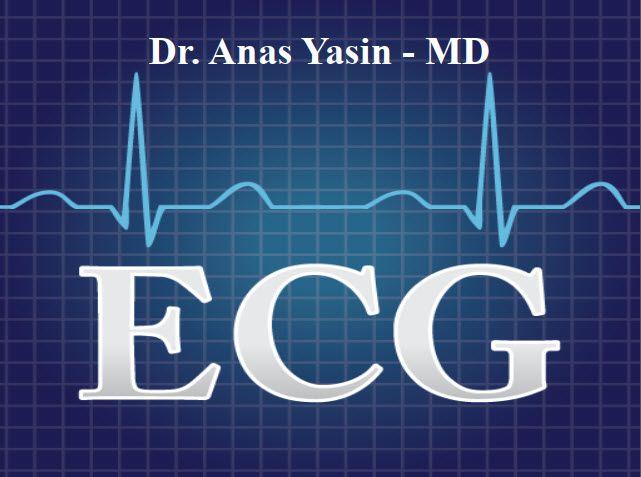ECG Basics PDF By Dr. Anas Yasin – MD

Please support this website by 1 , 3 or 5 $$
Files Size:: 4.1 MB
Dr. Anas Yasin – MD
—————————————————–Page 1—————————————————–
Basics
• ECG is a recording of electrical activity. • Records average of all electrical activity. • 12 recording leads.
• Toward lead – Positive deflection. • Away – Negative deflection.
—————————————————–Page 2—————————————————–
—————————————————–Page 3—————————————————–
Atrial contraction
QRS complex
Ventricular depolarization and
contraction
T wave
Ventricular repolarization
U wave
Represents final stage of ventricular
repolarization (papillary muscle)
—————————————————–Page 4—————————————————–
—————————————————–Page 5—————————————————–
ECG Leads
• I & aVL: Lateral.
• II & III & aVF: Inferior. • aVR: R.A
• V1 & V2: RV
• V3 & V4: Septum & Anterior LV • V5 & V6: Anterior & Lateral LV. • Posterior ??? & R.V
—————————————————–Page 6—————————————————–
—————————————————–Page 7—————————————————–
QRS
shape
—————————————————–Page 8—————————————————–
ECG Reading 1
Prerequisites (Practical points):
1. Electrodes are attached to correct arms.
(legs??)
2. Good electrical contact. 3. Calibration & speed rate. 4. Patient relaxed.
—————————————————–Page 9—————————————————–
ECG Reading 2
5 Steps:
1. Rhythm / Rate.
2. Conduction interval. 3. Axis.
4. QRS >> (wide, narrow, morphology).
5. ST segment and T-wave >>>> (depression,
elevation, inversion).
—————————————————–Page 10—————————————————–
Rhythm
• Refers to part of heart which is controlling the
activation sequence.
• Normal is sinus ( there is P – wave) — SA is
the leader.
• P wave best seen on lead 2 & V1.
• No P – wave : Arrhythmia __ another story.
—————————————————–Page 11—————————————————–
Rate
Rule of 300:
• ECG machine velocity: 25mm/s = 5 large squares/s. How many squares per min??
Rule of 10 sec:
• Count QRS complex in 10 sec (how many
squares) then multiply by 6.
• Good for irregular heart beats.
—————————————————–Page 12—————————————————–
What is the heart rate?
www.uptodate.com
(300 / 6) = 50 bpm
—————————————————–Page 13—————————————————–
What is the heart rate?
www.uptodate.com
(300 / ~ 4) = ~ 75 bpm
—————————————————–Page 14—————————————————–
What is the heart rate?
(300 / 1.5) = 200 bpm
—————————————————–Page 15—————————————————–
Conduction intervals
PR interval : time from SA node till ventricular depolarization (Through out conduction system). (0.08 – 0.2 s) (3-5 squares).
• Short < 3: near AV or Accessory bundle • Long > 5: Block
QRS : Time of ventricular depolarization.(0.12 s)
(3 squares).
—————————————————–Page 16—————————————————–
Cont ,,,
QT : Time of ventricular depolarization &
repolarization.
• Varies with HR >> correction: QTc = QT/RR 1/2 • QTc is prolonged if > 440ms in men or > 460ms in
women
• QTc > 500 is associated with increased risk of
torsades de pointes
• QTc is abnormally short if < 350ms
• A useful rule of thumb is that a normal QT is less
than half the preceding RR interval
—————————————————–Page 17—————————————————–
11 – 5 o’clock
—————————————————–Page 18—————————————————–
Right Axis deviation
Tall thin person.
Lung problems: PE, RVH, pneumothorax. Posterior fascicular block.
—————————————————–Page 19—————————————————–
Left axis deviation
Short fatty persons. LVH
Anterior fascicular block. IWMI.
—————————————————–Page 20—————————————————–
—————————————————–Page 21—————————————————–
Common topics
Heart Block: 1. AV – Block
2. Bundle Block.
Myocardial infarction. LVH & RVH.
—————————————————–Page 22—————————————————–
—————————————————–Page 23—————————————————–
1 st degree heart block
• How did you know???
—————————————————–Page 24—————————————————–
Second-Degree Heart Block: Mobitz Type I – Wenckebach
P
Progressive lengthening of PR interval until a QRS is not conducted (ventricular contraction does not occur)
—————————————————–Page 25—————————————————–
Second-Degree Heart Block
Mobitz Type II
How did you know???
Constant PR interval before a skipped ventricular conduction
—————————————————–Page 26—————————————————–
THIRD DEGREE AV BLOCK
—————————————————–Page 27—————————————————–
Bundle block
• RSR 1 (V1,V2) : RBBB • RSR 1 (V5,V6) : LBBB
• RBBB + LAD : Bifasicular block.
• 1 st degree + bifasicular : Trifasicular block.
—————————————————–Page 28—————————————————–
RBBB
—————————————————–Page 29—————————————————–
LBBB
—————————————————–Page 30—————————————————–
—————————————————–Page 31—————————————————–
—————————————————–Page 32—————————————————–
Low voltage ECG
• The amplitudes of all the QRS complexes in the limb leads are < 5 mm; or • The amplitudes of all the QRS complexes in the precordial leads are < 10
mm
• Causes:
Pericardial effusion Pleural effusion Obesity
Emphysema
Pneumothorax
Constrictive pericarditidis Previous massive MI
End-stage dilated cardiomyopathy
Restrictive cardiomyopathy due to amyloidosis, sarcoidosis,
haemochromatosis
—————————————————–Page 33—————————————————–
Low voltage ECG
—————————————————–Page 34—————————————————–
MI – changes
—————————————————–Page 35—————————————————–
MI – Leads – vessel
—————————————————–Page 36—————————————————–
—————————————————–Page 37—————————————————–
—————————————————–Page 38—————————————————–
For previous ECG
—————————————————–Page 39—————————————————–
—————————————————–Page 40—————————————————–
For previous ECG
—————————————————–Page 41—————————————————–
What is the DX ?
www.uptodate.com
Inferior – posterior MI
—————————————————–Page 42—————————————————–
What is the DX ?
www.uptodate.com
Anterior MI
—————————————————–Page 43—————————————————–
What is the DX ?
www.uptodate.com
LBBB
—————————————————–Page 44—————————————————–
RBBB – LAFB
—————————————————–Page 45—————————————————–
What is the DX ?
www.uptodate.com
Third Degree Heart
Block
—————————————————–Page 46—————————————————–
What is the DX ?
www.uptodate.com
Normal sinus rhythm
—————————————————–Page 47—————————————————–
What is the DX ?
www.uptodate.com
SVT
—————————————————–Page 48—————————————————–
What is the DX ?
www.uptodate.com
—————————————————–Page 49—————————————————–
• Sinus rhythm.
• Cardiac axis is normal.
• Pathologic Q waves can be seen in leads V2 and
V4.
• There are raised ST segments in leads V2-V4. • There are T wave inversion in leads V2 – V6, I &
aVL.
• This is acute anterolateral myocardial infarction.
—————————————————–Page 50—————————————————–
—————————————————–Page 51—————————————————–
• Ventricular rate of approximately 175 bpm. • Broad QRS complexes. • Left axis deviation.
• This is a ventricular tachycardia.
—————————————————–Page 52—————————————————–
—————————————————–Page 53—————————————————–
• Irregular ventricular contraction. • Irregular trace baseline. • Cardiac axis normal.
• Narrow QRS complexes. • This is atrial fibrillation.
—————————————————–Page 54—————————————————–
—————————————————–Page 55—————————————————–
• Sinus rhythm.
• Normal conduction intervals. • Normal cardiac axis.
• There are Q waves in leads V2 to V4.
• There are inverted T waves in leads V2 to V6,
VL and I.
• This is an old anterior myocardial infarction.
—————————————————–Page 56—————————————————–
—————————————————–Page 57—————————————————–
—————————————————–Page 58—————————————————–




Leave a Reply